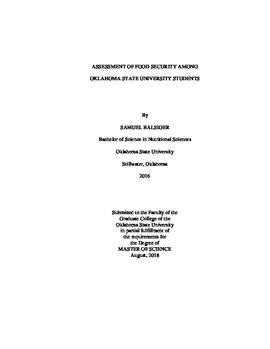| dc.description.abstract | Food security is emerging as a serious problem in the United States and in particular, the state of Oklahoma. Food security research has shown students at postsecondary institutions are not immune to food insecurity. Research has shown rates of food insecurity at postsecondary institutions are higher than the national average. At Oklahoma State University, a survey was developed and distributed by e-mail to a random sample of 5,000 students. The survey contained questions concerning student's dietary, food security, food pantry, health status, and demographics. Five hundred and forty-four students completed the survey and were included in the data analysis. Food security status was determined using the USDA six-item short form. Results revealed 42.46% of students were food insecure (16.73% were low food secure and 25.74% were very low food secure). When they did not have enough food, students reported they "often" or "sometimes" ate smaller meals (53.12%), stretched meals (53.67%), and skipped meals (46.51%). There was a significant difference by food security status in the distribution of students who reported "often" or "sometimes" engaging in these behaviors, with higher percentages among food insecure students. On "most days," 45.12% of students reported they ate breakfast and 34.50% had the food they needed to make healthy meals. A significant difference was found by food security status in the distribution of students engaging in these behaviors, with lower percentages among food insecure students. A significant difference was found by food security status in the distribution of students who were comfortable understanding food labels, planning menus, writing a shopping list, selecting health foods at the grocery store, and preparing meals, with lower percentages among food insecure students. Only 36.76% of students reported they were aware of the local food pantry and students reported barriers to using food pantries. Overall, findings from this study show there is a high prevalence rate of food insecurity among Oklahoma State University students and prevalence of many anticipated risk factors were significantly different by students' food security status. Nevertheless, there is an opportunity for a local food pantry to aid students who are suffering from food insecurity. | |
